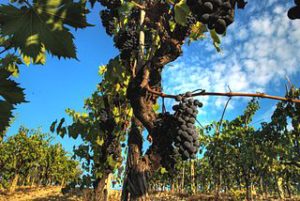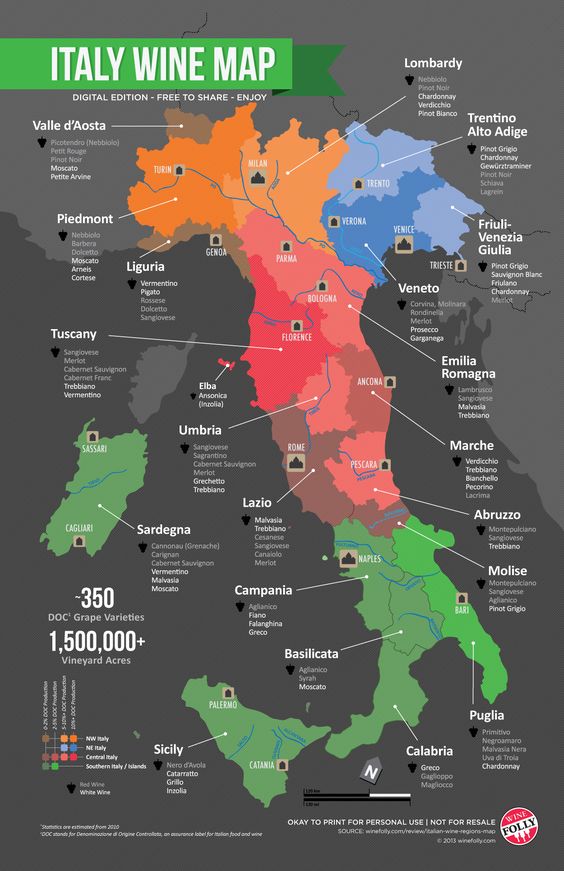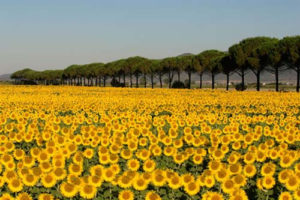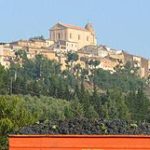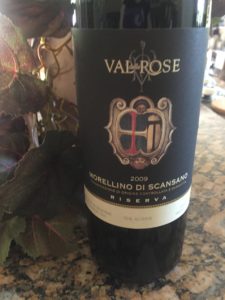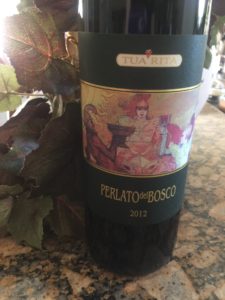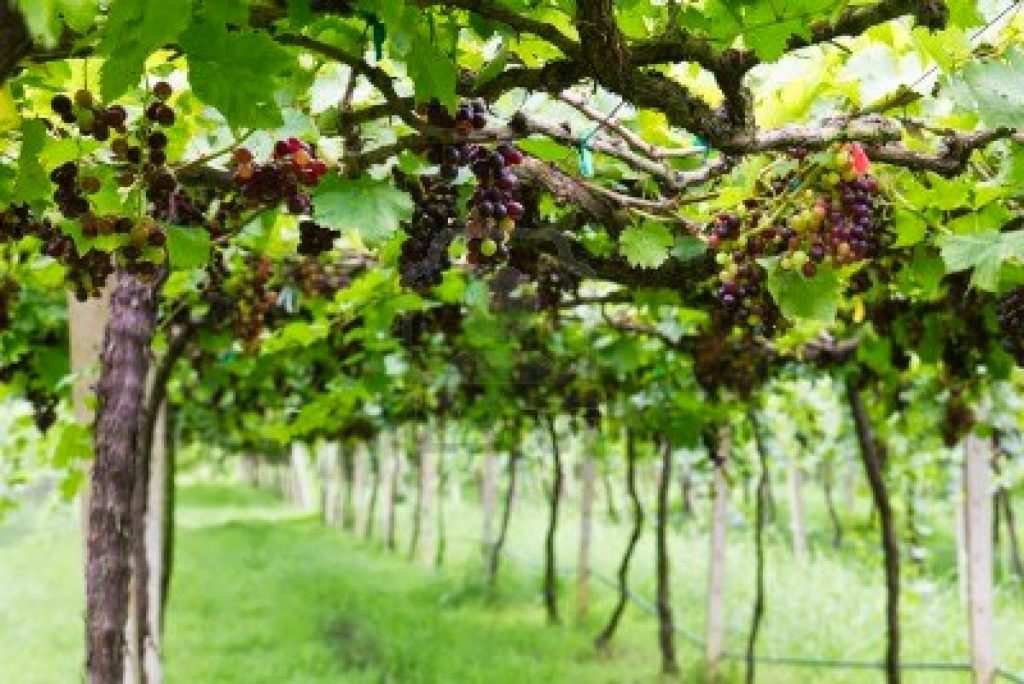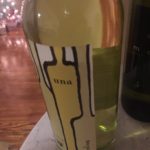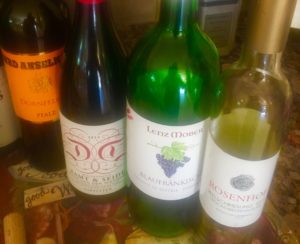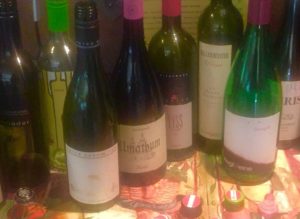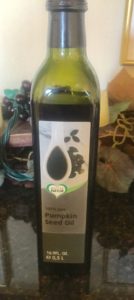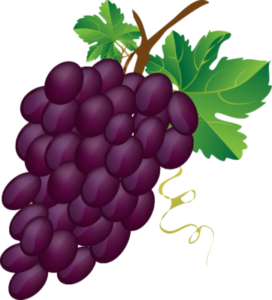Grapevines grow literally everywhere in Italy.
Italy is the leading producer of wine in the world. The International Organization of Vine and Wine (OIV), those folks who provide us with annual data on world wine production, estimates the wine producers of the world made around 260 million hectoliters in the year 2016, and we consumers drank about 240 million hectoliters. Since one hectoliter equals 26.417 gallons, that is about 6.3 billion gallons of wine consumed around the world!
The OIV estimates that Italy will have produced 48.8 million of those 260 million hectoliters in the 2016 harvest. Just in case you are wondering who was number 2 and where did the United States rank, France was estimated to have almost 42 million, Spain at 37.8 million and US holding the number 4 spot for another year with 22.5 million hectoliters. (Numbers are subject to change.)
Wine in Italy goes back over 4000 years. When the Greeks first came to Southern Italy, they even named the country Oenotria, “the land of wine”. The Etruscans and Romans were all interested in making wine. Italy continued to refine winemaking techniques throughout the middle ages and became known for making excellent wines. Then along came phylloxera to Northern Europe in the nineteenth century, destroying many Italian vineyards. Unfortunately those lost vineyards were replanted for quantity, not quality, thus leading to the production of inexpensive table wines. If you drank Italian wine in the 1960s, it was more than likely in a straw-covered bottle, technically called a fiasco, which described a glass bottle with a long neck and bulbous body covered in wicker or 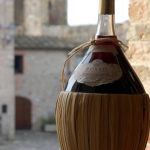 straw for protection. The Oxford English Dictionary says the word fiasco means “a failure or complete breakdown”. We can only speculate that the quality of the wine had something to do with the term. And this was the status of Italian wine until after the 1960s when laws were passed to control wine quality and labeling.
straw for protection. The Oxford English Dictionary says the word fiasco means “a failure or complete breakdown”. We can only speculate that the quality of the wine had something to do with the term. And this was the status of Italian wine until after the 1960s when laws were passed to control wine quality and labeling.
There are 20 regions, or administrative divisions like our 50 states, in present day Italy. These regions, except for the Aosta Valley, are then divided into 110 provinces and just to further complicate the governing structure, there are also 14 special Metropolitan cities. All of these regions produce wine to some extent; however some are much more significant than others: Tuscany, Piedmont, Veneto and Fruili – Venezia Giula. There are over 350 documented “authorized” varietals indigenous to Italy and another 500 or more documented in circulation in Italy with as many as 2000 grape varietals grown throughout Italy. According to Wine Folly, a website and wine education company, “if you tasted a new Italian wine each week, it would take you 20 years to taste your way through Italy”!
Italian wine can vary drastically from region to region or even estate to estate even if it is made from the same grape varietal. Winemaking style has something to do with this, but the terroir changes so dramatically due to the many mesoclimates throughout the country. Italy is about 40% mountains and another 40% hills. Much of the country borders on one of four seas: the Mediterranean, the Tyrrhennian, the Ligurian and the Adriatic. A lot of the soil has also been impacted by earthquakes throughout the years. You can expect your Sangiovese and other varietals to taste different in all of these areas similar to how Pinot Noir tastes much different in the Central Coast, Russian River Valley and Oregon.
Introduction of Italian Wine Laws
As in France, Italy has a wine classification system. French wines were first systematically organized in 1937, but Italy did not begin to classify until the 1960s with the first Italian DOC laws enacted in 1963. The first wine given DOC status was the Tuscan white Vernaccia di San Gimignano in 1966. Here is what those classification initials mean:
DOC – Denominazione di Origine Controllata – Controlled designation of origin (a quality control label in Italy for both wine and cheese).
DOCG – Denominazione di Origine Controllata e Garantita – The highest level of quality assurance.
IGT –Indicazione Geografica Tipica – Typical geographic indication; wines of the region; wines with non-Italian grapes usually fall under this designation; i.e. superTuscans.
IGP – Indicazione di Originie Protettiva – A more current term similar to IGT, but it conforms to EUs (European Union) terms of Protected Geographical Indication or PGI.
VdT – Vino da Tavola – Literally means “table wine” intended for everyday drinking as it is unsuitable for aging. The wine has to come from Italy and can be made from grapes of any region.
There are 334 DOCs and 74 DOCGs for a total of 408 Denominazioni di Origine Protetta (DOP) in Italy. Visit www.italianwinecentral.com to see the complete list of Italian quality-wine denominations as of July 2016.
What about Sangiovese? (san joe VAE sae)
Two of the most commercial and significant of those approximately 350 Italian grape varietals are Nebbiolo and Sangiovese. You will not find these varietals growing significantly in any other world wine region except for in very small quantities. Nebbiolo is predominant in the Piedmont northwestern Italian region. Sangiovese can be found mainly in central Italy; however it does also exist in the north and south. A 2007 ampelographic study confirmed that Sangiovese came from the Ciliegiolo grape (meaning “cherry” in Italian) and the Calabrese Montenuovo grape grown somewhere in the Apennine Mountains between the regions of Tuscany and Romagna.
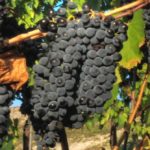 Sangiovese is the official authorized grape varietal for planting in 53 provinces and is recommended by law in an additional 13 of the 107 total provinces and 14 special metropolitan cities. Sangiovese represents 10% of the just under 2 million acres of vineyard plantings in Italy, has dozens of different clones and may be closely related to many other grapes.
Sangiovese is the official authorized grape varietal for planting in 53 provinces and is recommended by law in an additional 13 of the 107 total provinces and 14 special metropolitan cities. Sangiovese represents 10% of the just under 2 million acres of vineyard plantings in Italy, has dozens of different clones and may be closely related to many other grapes.
While there are more than 250,000 acres of Sangiovese planted in many different clonal variations, just two clones are predominant:
- Sangiovese Grosso – (Large Sangiovese) or Brunello, Prugnolo Gentile and Sangiovese di Lamole. It has larger more loosely bunched grapes, is more widely cultivated and yields a larger crop.
- Sangiovese Piccolo – (Small Sangiovese) or Sangioveto. It has smaller grape clusters than the Grosso clone.
In those old days of straw wrapped bottles and red checkered table cloths, Sangiovese was overproduced, often blended with white grapes and exhibited high acids and unripe tannins. Thank goodness for winelovers, the quality drastically improved beginning in the 1980s with the help of Italian Wine Laws in the 1960s. Today Sangiovese is the product of much lower yields with a real concentration of color and savor and is considered one of the nine noble red grape varietals, which are grapes widely planted in most major wine producing regions and are very popular.
What’s it taste like? It offers a wide range of tastes from earthy and rustic to round and fruit forward. Here are some of the many descriptors used: tart or sour red cherry, strawberry, red plum, mulberry, prunes, carob, chestnuts, rhubarb, roasted pepper, tomato, tea, cloves, coffee, cedar, tobacco, dried roses, violet, peony, potpourri, licorice, anise, toast, clay, brick, smoke, marjoram, oregano, thyme, pinewood, capers, truffles, mushrooms, moss, ferns, pencil lead and leather. However there is one taste you should be able to count on — it always exhibits cherry flavors.
The Sangiovese grape also has thinner skin which leads to easier winemaking; therefore you need really good winemakers and producers to create really good Sangiovese wines. The grape is praised for a balanced acidity (high) with firm tannins which maintains aging while being ready to drink younger. It is usually aged in neutral oak barrels for normally 4-7 years and 10-18 for Brunellos.
Where does Italian Sangiovese come from?
Any practicing winelover who drinks Sangiovese should know about these Italian regions, DOPs, DOCs and DOCGs. Some of them are synonymous with “Sangiovese” in Italy and have been famous since the 19th century while others may be more up and coming as in the late 20th and early 21st centuries. There are other regions growing plenty of Sangiovese, but it may be blended and/or very little makes its way to wine shelves in the US. Highlights about each region or DOP follow.
Sangiovese is “The Soul of Tuscany”
Tuscany, or Toscana in Italian, is THE leading and best known region for Sangiovese wines even though it is present in 259 DOCs across the country. Tuscany is located in central Italy along the Tyrrhenian coast and is home to some of the world’s most famous wine regions. Wine producers have been working with Sangiovese for over 250 years in Tuscany.
Tuscany has 35 DOCs and 11 DOCGs plus the very famous Super Tuscans, but these are the wine denominations you should know in Tuscany.
THE “CHIANTI ZONE”
- The “Chianti Zone” is a wine region in Tuscany (Toscana) making Sangiovese-dominated blends and includes all of the subdistricts of Chianti and Chianti Classico which is a major part of central Tuscany. It is probably the most well-known Italian Sangiovese region especially to wine drinkers in the United States. A Chianti wine is any wine produced in the Chianti wine region. Chiantis have savory flavors paired with high acidity and coarse tannin which makes for incredible food wines.
- Both Chianti and Chianti Classico have their own DOCGs, and the wines of both are extremely different. The blend of grape varietals must follow the authorized formula for that DOCG.
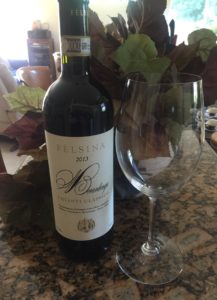
- Historically only local grape varietals like Sangiovese (also known as Sangioveto in Chianti), Colorino, Canaiolo and Ciliegiolo plus a white variety (Trebbiano or Malvasia) were permitted in the Chianti blend. Nowadays some wineries are adding non-Italian varietals like Cabernet Sauvignon. Chiantis tend to be simpler and easier to drink. Chianti is traditionally aged in large Slavonian oak casks.
- Chianti’s international reputation diminished by the mid -1970s but began to improve due to some innovative producers who did not want to see the demise of Italian winemaking.
CHIANTI DOCG
- The basic modern Chianti in the Chianti DOCG can be anywhere from 75 – 100% Sangiovese. Canaiolo can be no more than 10% of blend with other authorized reds making up no more than 15%. White Malvasia and Trebbiano used to make up to 10% of Chianti blend but the wine laws were rewritten in 1984 and white wine was no longer allowed in the blend. The Chianti DOCG was also designated.
- There are 8 subzones in Chianti and their name appears on the wine label: Colli Fiorentini, Montespertoli, Chianti Rufina, Colli Aretini, Colli Senesi, Colline Pisane, Montalbano and the Chianti Classico DOCG.
- Chianti from a named subzone can have up to 20% of “other authorized reds” – not 15% as in the basic Chianti.
CHIANTI CLASSICO DOCG
- Chianti Classico is one of the 8 Chianti subzones but also has its own DOCG.
- Wine and grapes in a Chianti Classico come from the oldest and usually best part of the Chianti region and must be at least 80% Sangiovese. The other grapes must be Canaiolo, Colorino, Cabernet Sauvignon, and/or Merlot.
- A Chianti Classico Reserva must be aged, by law, at least 2 years in wood and 3 months in the barrel. Most Classico Reservas are aged in small new French oak barrels thus making a fuller more complex wine.
- Chianti Classico Gran Selezione was introduced in 2014 as an even higher quality than Reserva. It must be made from estate-grown grapes and aged 30 months including 3 months in bottle before it can be sold and has to pass a suitability test conducted by authorized labs and be approved by a special tasting committee.
- The best Chianti Classicos have plum and dried cherry flavors; sometimes with a bit of salt and spice. Reservas may display fig, chocolate, cedar, dried orange, earth, smoke, saddle leather, prune, minerals, salt and exotic spices.
- Ever notice the black rooster on a bottle of Chianti Classico? The black rooster, or gallo nero, was officially adopted by the Chianti Classic Wine Consortium in 2005, and the wine isn’t an official Chianti Classico without it on the bottle. A red circle around the rooster means regular Classico and a gold circle indicates a Riserva.
SUPER TUSCANS AND THE BOLGHERI/BOLGHERI SASSICAIA DOCS
- After Chianti’s reputation began to dwindle, some winemakers became fed up with the rules they had to follow to make DOC wines. This meant they had to label their wines as Vino Da Tavola or “table wine”. So along came what we know as “Super Tuscans”.
- Sassicaias were the inspiration for the first non-Chianti Chiantis that helped to revitalize winemaking in Italy. Sassicaia means “rocky place” and comes from Bolgheri in the Maremma district in the far west of Tuscany along the coast of the Tyrrhenian Sea. It was produced by Incisa della Rochetta and first released commercially in 1968. Cabernet Sauvignon is the leading red grape in this wine.
- Antinori’s Tignanello was the first well-known non-Chianti Chianti. It was first based almost entirely on Sangiovese; Cabernet Sauvignon then was added.
- Super Tuscan blends are full bodied and aged in French barriques instead of the normal oak from Slavonia. Some are Bordeaux grape style; others are not. As a side note, a French barrique is made of French oak and can hold between 59 to 79 gallons. The type of oak and age and size of the barrel all result in wines with unique characteristics, but that would be a topic for another whole discussion!
- Super Tuscan blends frequently contain Cabernet Sauvignon, Merlot or Cabernet Franc as well as other non-native Italian grapes or they can even be 100% Sangiovese.
- The IGT Indicazione Geografica Tipica was created as a designation allowing for experimentation such as a Super Tuscan as long as the grapes come from the area where the wine in made. Now winemakers of the Tuscan coast focus on making wines that represent the geography of where those grapes come from. Super Tuscans may have put it on the map, but now it is all about the territory.
BRUNELLO DI MONTALCINO DOCG
- Montalcino is a hilltop town in Tuscany within the Chianti zone south of Florence.
- Brunello was granted DOCG status in 1980, one of the first reds to gain this status. Brunello wines are Sangiovese at its best, possibly the most famous and often the most expensive of the Montalcinos and Vino Nobile di Montepulcianos. They are high to premium priced wines.
- They were first promulgated by Biondi Santi in the late 19th century who bottled the first official Brunello di Montalcino in 1888.
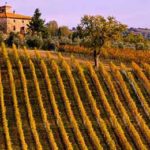
- Brunellos are 100% Sangiovese Grosso clone grapes unlike Chianti’s blended wines. They are rich, elegant and full-bodied with incredibly smooth tannins and complex aromas and flavors of blackberry, black cherry, black raspberry, chocolate, violet, tar, cinnamon and leather.
- Brunellos are aged in large vats which are often made of Slovenian oak. Slovenian oak is more neutral than French or American oak. Some are aged in small barriques which give vanilla tones to the wine. They must be aged at least 2 years in wood casks and another 3 years in the cellar; thus it takes at least 5 years after harvest for release. Riservas require an extra year of cellar aging – it’s the Italian wine that stays in the cellar longest by law — aging up to as many as 25 years.
- 2008’s infamous Brunellogate, or Brunellopoli, was the result of blending non-authorized grapes! Defendants were accused of “making false statements to public officials and of selling adulterated substances and falsely labelled industrial products that do not comply with the Brunello regulations.” Rumors of this practice had previously been circulating for years and finally resulted in guilty verdicts, fines, sentences and tarnished reputations. Discussions about possibly relaxing some of the Brunello wine laws ensued; however, the laws remained in place and winemakers know what may result if they are not followed.
ROSSO DI MONTALCINO DOC
- You may think of Rosso as Brunello’s younger sibling which would be a good comparison as Rosso is made from the earlier maturing red grapes of Montalcino which are also 100% Sangiovese Grosso. Rosso received DOC status in 1984 in order to differentiate it from Brunello di Montalcino.
- It’s less austere than Brunello and less expensive. A plus for the winemakers – they can make some money while waiting for their Brunellos to age! A plus for winelovers – a Rosso can be a really good choice especially during years when producers declassify their Brunellos and make Rosso di Montalcino with them instead!! Discussions regarding a change in Rosso wine laws also resulted in their retention.
- A good Rosso should have a depth of black cherry, wild-berry fruit, and hints of spice and vanilla. It is considered a more lively style of wine than the more austere Brunellos.
VINO NOBILE DI MONTEPULCIANO DOCG
- Montepulciano is also in Tuscany and located just to the east of Montalcino.
- Vino Nobile di Montepulciano comes from the Prugnolo Gentile clone and must be a minimum of 70% Sangiovese. “Prugnolo”, which means little prune, refers to the prunelike shape, color and aroma of the grapes. The remainder of the blend may be Canaiolo Nero and Mammolo.
- Vino Nobile wines are dark and earthy with subtle overtones of dried herbs or blue flowers.
- These wines must be aged at least one year in oak and two years overall before leaving the winery thus making them a less expensive alternative to Brunellos.
- The vineyards of Montepulciano surround the city of Siena, near the southern end of the Valley of Chiana. Chiana is the home of Tuscany’s special breed of white cattle named Chianina often served up as a mammoth T-bone steak called bistecca alla florentina.
- Do not confuse this region with Montepulciano d’Abruzzo! Montepulciano is another red grape varietal found in the region of Abruzzo in Central Italy.
- Rosso di Montepulciano is the less expensive “younger sister” of Vino Nobile di Montepulciano. The DOC was created in 1989, but the Rosso style that we know and enjoy didn’t really come about until 1999 when the DOC rules were amended. Regulations now allow it to be made in the same area of production around the town of Montepulciano and from similar grape varietals as the Vino Nobile di Montepulciano DOCG of Siena, such as native Mammolo and/or internationals Merlot and Cabernet Sauvignon (maximum 20%).
- It is also made from Prugnolo Gentile clones but in slightly different percentages of the DOCG wines: minimum 70% Sangiovese combined with maximum Canaiolo and other permitted varietals of Siena and/or Merlot and Cabernet Sauvignon.
- Vineyards are usually younger and the wine aged for 6 months compared to 24 months for the Vino Nobile.
- The quality is entirely dependent on the producer but generally it is an easier-drinking, fresher and fruitier version of Vino Nobile. It is medium bodied and has aromas of violets just like big brother.
CARMIGNANO DOCG
- Carmignano is a tiny wine region just west of Florence. It was one of Italy’s earliest regulated wine names, long before the country’s DOC/G system was introduced in the late 1960s.The Grand Duke Cosimo III de’ Medici established Carmignano as a nursery for grape varietals way back in the early 1700s. He also planted Cabernet Sauvignon which was imported from France. The Grand Duke issued decrees controlling wine production and sales enforced by his Congregazione di Vigilanza. Carmignano was later absorbed into the Chianti regulations, then became its own DOC in 1975 and was upgraded to a DOCG in 1990.
- That Cabernet Sauvignon planted by the Grand Duke is Carmignano’s claim to fame. Carmignano wines are dry red and must contain a minimum of 50% Sangiovese plus 10-20% Cabernet Sauvignon and Cabernet Franc. The rest is Canaiolo, white grapes and other authorized reds. Rosso must be aged for a minimum of 20 months with a minimum of 8 months in the barrel. Riserva requires a minimum of 3 years aging including 12 months in the barrel. Cabernet Sauvignon has been allowed in the Chianti blend since 1996.
- There are fewer than 20 producers here and Villa de Cappezzana makes what many Italian winelovers consider to be the best Carmignano. A Cappezzana can be medium to full-bodied with lots of dark fruit – boysenberry, blueberry, black cherry – combining with notes of slate, earth, tobacco, and licorice or can be more aromatic with notes of chocolate, licorice and dark fruit.
COASTAL TUSCANY
- The Tuscan Coast, or the Maremma, didn’t even exist as a high quality wine production area just 35 years ago. Now winelovers around the world know about the famous Sassicaia and Ornellaia from Bolgheri and Tua Rita from a little further south. The Maremma runs from the northern part where Bolgheri is located, called Maremma Livornese or Alta “high” Maremma, to the southern part known as Maremma Grossetana.

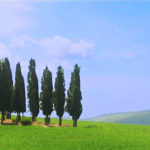
- MORELLINO DI SCANSANO DOCG is from the hilly village of Scansano in the southern Maremma region and definitely a Maremma Sangiovese wine area to know. “Morellino” is the local name for the Sangiovese varietal here and the wine must be at least 85% Sangiovese. Morello (brown) is the color of the region’s horses but the name may also come from the Morello cherry, a dark red cherry which is very tart and acidic. Morellino di Scansano became a DOC in 1978 and was later upgraded to DOCG with the 2007 vintage. It’s an easier to produce and less expensive Sangiovese-based wine – vineyard land here is less expensive and the grapes are a little easier to ripen. Regular or normale Morellino di Scansano wine does not need to age in wood and can be released and on the shelf at less than 8 months old. This makes it a crisp wine with fresh fruit characteristics and is excellent with food. “First Selections” Morellino wines are aged in wood for 4 to 12 months. Riserva Morellino must be aged for 2 years with at least at least 1 year in wood for and can be released two years after harvest. All of this means that the characteristics of a Morellino wine can vary significantly from producer to producer and even label to label. Not a lot of these wines find their way to the US, but if you find them they are generally a good value for the price.The Maremma Toscana DOC and Montecucco Sangiovese DOCG subzones both produce rich sun-drenched grapes with jammy notes of blackberry and strawberry and the best known bright cherry flavors. Sangiovese is widely planted in the home of the Super Tuscans; however it is most often used as a blending grape in Massa Carerra, Lucca, Pisa, Livorno and Grosseto, the coastal provinces of Tuscany.
- The MONTECUCCO DOCG was elevated from a DOC in 2011 and can be found between Montalcino and Scansano. The wines are known for their fine tannins, sweet fruit aromas and rich black-cherry flavor. They must be at least 90% Sangiovese, and oak barrel aged for 12 to 24 months depending on whether regular or riserva. These wines are a good value compared to their more expensive Montalcino cousins, but with less than 20,000 cases made don’t expect to find much if any.
Other Italian regions and DOPs With Sangiovese significance
LIGURIA
- Liguria is a small crescent shaped strip of land on the coast of the Mediterranean Sea known as the Italian Rivieria. Much of the wines here are kept for local consumption, but there are a few well worth trying. There are only 14,800 acres of vineyards here and 75% of wine produced is white – Vermentino. The coast of Liguria has high steep hills that look like they drop straight into the sea. Some vineyards can only be reached by boat!
- Colli di Luni, “hills of the moon”, DOC is based on Sangiovese (at least 50% of it) blended with other local varietal grapes. Look up and you will see the distinctive white and blue-grey Carrara marble in the hills above. You may not have much luck finding Colli di Luni Sangiovese on wine shelves near you, but if you do be sure to give it a try.
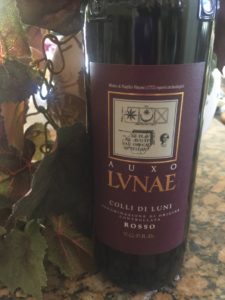
- Colline di Levanto DOC covers four villages on the coast with 26 acres of vines planted where topography allows. Some are high up on clifftops so close to the sea that they are moistened by salty sea spray. The rosso wines must have a 30% minimum of Sangiovese with the remainder local reds. Don’t expect to see many or any of these wines outside of Italy!
UMBRIA
- Umbria is a neighbor of Tuscany and the only Italian region without access to the sea or another nation. It is often called the “green heart of Italy”. White wines were always the most significant here but recently two reds have gained in popularity – Sangiovese and Sagrantino. Sangiovese is the grape used for two Umbrian DOC/G wines. You can expect to find some really nice undervalued Italian wines from Umbria just waiting to be discovered.
- Torgiano Rosso Riserva DOCG contains Sangiovese 50-70% and Riserva must age at least 3 years with 6 months minimum in bottle. This meets same aging requirement as a Chianti Gran Selezione, Chianti’s highest
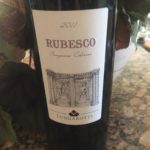 quality tier. You should expect notes of raspberry, strawberry, hide leather and subtle potpourri. Tannins are bold with notes of coffee or cocoa powder with tangy acidity. Consider putting it away for 10+ years. If you visit Torgiano, don’t miss the Lungarotti’s museo del vino, or wine museum known as MUVIT, where you will see one of the most impressive personal collections of wine artifacts in Italy or their Olive and Oil Museum known as MOO.
quality tier. You should expect notes of raspberry, strawberry, hide leather and subtle potpourri. Tannins are bold with notes of coffee or cocoa powder with tangy acidity. Consider putting it away for 10+ years. If you visit Torgiano, don’t miss the Lungarotti’s museo del vino, or wine museum known as MUVIT, where you will see one of the most impressive personal collections of wine artifacts in Italy or their Olive and Oil Museum known as MOO. - Montefalco Rosso DOC wines are 60-70% Sangiovese and 10-15% Sagrantino which may be the world’s most tannic red wine. The tannins in Sagrantino are similar to that of pure cocoa. If you
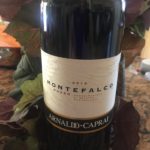 cellar your Sagrantino wines properly, they can age for 30+ years. Montefalco Rosso wines with their splash of Sagrantino have deeper color, more tannin and richer plummy fruit than many other Italian Sangiovese-based wines. It has been referred to as “Sangiovese on crack”! You can expect raspberry, strawberry, cinnamon, leather and rose aromas with bold, spicy, medium to high tannin and acidity. Drink 3 to 10 years from its vintage.
cellar your Sagrantino wines properly, they can age for 30+ years. Montefalco Rosso wines with their splash of Sagrantino have deeper color, more tannin and richer plummy fruit than many other Italian Sangiovese-based wines. It has been referred to as “Sangiovese on crack”! You can expect raspberry, strawberry, cinnamon, leather and rose aromas with bold, spicy, medium to high tannin and acidity. Drink 3 to 10 years from its vintage.
EMILIA-ROMAGNA AND THE ROMAGNA DOC
- Emilia-Romagna actually consists of two regions and is considered by many as Italy’s ultimate food region. Parmigiano-Reggiano, balsamic vinegar and prosciutto di Parma Romagna rank high on most culinarian’s list of favorites. The wine is just sort of a bonus to go with them. Emilia is best known for frizzante or frothy-style wines (Lambrusco of the old days??).

- Romagna is the south-eastern portion of Emilia-Romagna, bordered by Tuscany and extends to the Adriatic coast. We concentrated on Romagna because it is the most important Sangiovese-based region outside of Tuscany. Sangiovese di Romagna obtained DOC status way back in 1967, the first DOC in the region, and has since become incorporated into the Romagna DOC in 2011.
- Best known in the past for its bulk wines, most of the vineyards here were replanted in the 1990s resulting in some wines that continue to improve with every vintage and shake off that bulk wine image. Now some Tuscan producers are actually using Sangiovese clones from Romagna since years of research resulted in finding that R24 and T19 are two of the finest Sangiovese clones, and they are actually from Romagna. The clones here are more fruit oriented with smoother and more open tannins than those in Tuscany. The official Romagna DOC blend has to contain at least 85% Sangiovese and up to 15% other approved grape varietals. The amount of other allowed grapes in a specified subzone has been decreased from 15 to 5% to highlight the importance of Sangiovese in Romagna. You can expect a ruby red wine with violet and blackberry accents with dry, balanced, and silky tannins capable of aging in your cellar. It is excellent with roasts and grilled meats.
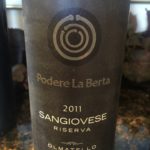
MARCHE (MAR-kay)
- Le Marche is located on the eastern edge of central Italy and is a wine region to be taken seriously. Over the last decades, the move has been away from quantity towards quality. There are a number of DOCs (15) and DOCGs (5) but only a few wines actually make it here to US. Although Marche is best known for its whites, specifically Verdicchio, there are some excellent Sangioveses and Montepulcianos.
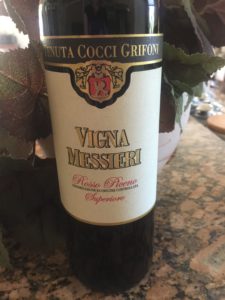 Rosso Piceno DOC wines must have between 35 to 85% Sangiovese grapes and 15 to 50% Montepulciano allowing for a max of 15% other grapes including some whites. This makes for a rich dark color wine with vibrant cherry notes and sweet tannins. Sangiovese is most often used to blend up to 15% with Montepulciano grapes in Rosso Conero DOC wines which results in a rich, dark color wine with aromas of black cherries and herbs and bold tannins. Pork dishes and pecorino cheese are most popular in the Marche region.
Rosso Piceno DOC wines must have between 35 to 85% Sangiovese grapes and 15 to 50% Montepulciano allowing for a max of 15% other grapes including some whites. This makes for a rich dark color wine with vibrant cherry notes and sweet tannins. Sangiovese is most often used to blend up to 15% with Montepulciano grapes in Rosso Conero DOC wines which results in a rich, dark color wine with aromas of black cherries and herbs and bold tannins. Pork dishes and pecorino cheese are most popular in the Marche region.
LAZIO (Latium) AND MOLISE DOC
- Lazio runs south from coastal Tuscany, ranks 8th in output of wine in Italy’s 20 regions, and 80% of the wine is white. Rome is located in Lazio, and it produces the most wine of any metropolitan area. Lazio is the home of Frascati. However, there are some reds called “Super Lazios” blended with Sangiovese that deserve mention. Just like the Super Tuscans, these wines are blended with French-origin varietals Cabernet Sauvignon, Merlot, Syrah, Petit Verdot and Cabernet Franc. Castelli Romani DOC, located just southeast of Rome, is an up-and-coming area for French-Lazio blends. These wines are usually declassified to Lazio IGT and very little is written about Lazio wines, but if you find any, they are definitely worth tasting.
- Molise is one of Italy’s smallest and most obscure wine regions; the wines are not very well known outside of Italy. There are 4 DOCs here and at least one of them produces Sangiovese wines that make it to our local wine shelves. Molise DOC is home to the Di Majo Norante Winery who produces 100% Sangiovese wines that are value-priced and have received some good ratings. Di Majo Norante Sangiovese typically displays aromas of violets, red berries, tart cherries, with undertones of cedar, leather and anise. It is a smooth soft easy-to-drink red wine.

SICILY (Sicilia) AND SARDENIA (Sardegna)
- Sicily and Sardinia are the two largest islands in the Mediterranean and share a long history of making wines that run the gamut from simple to spectacular. The revolution to start producing quality instead of quantity happened here, too. Sicily is Italy’s largest region and just a short ferry ride away from the mainland. Sardinia is much more remote at 125 miles from the mainland. Sardinia is famous for having so many people who live
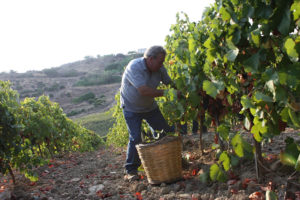 over the age of 100. Maybe it’s the wine!
over the age of 100. Maybe it’s the wine! 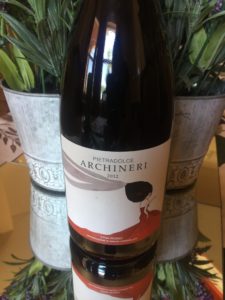
- Nerello is a name given to two varieties of red wine grapes that are grown primarily in Sicily and Sardinia. Nerello Mascalese is grown mainly on the northeastern side of Sicily. It can be used for blending, but the grape is often made into varietal Nerello Cappuccio is widely used in the Etna Rosso DOC as a blending grape that adds color and alcohol to the wine. The two are almost always blended together.
- An Italian study published in 2008 using DNA typing showed that Nerello Mascalese is quite probably the offspring of the Sangiovese varietal a close genetic relationship between Sangiovese on the one hand and ten other Italian grape varieties on the other hand, including Nerello. It is therefore likely that Nerello is a crossing of Sangiovese and another, so far unidentified, grape varietal. Nerello usually makes wines that are strong bodied, ruby red with fruity scent of red berry fruits, slight floral shades, spice, licorice and a bit of vanilla and tobacco.
- Etna is one of Sicily’s most exciting wine regions with vineyards planted in the black lava soil of its slopes. Mt.
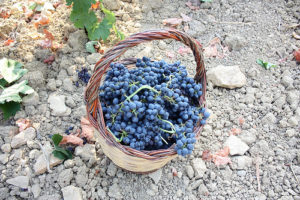 Etna reds are generally made from Nerello grapes and taste chalky, dusty, dry and bitter really requiring food to go with it.
Etna reds are generally made from Nerello grapes and taste chalky, dusty, dry and bitter really requiring food to go with it.
CORSICA
- Corsica is a French island about 60 miles west right off the coast of Italy, and it’s the birthplace of Napoleon Bonaparte. Corsica has been under Phoenician rule, Islamic rule, the City of Pisa and the Republic of Genoa. The Genoese gave control of the island to France in 1769, where it has remained ever since.
- Ampelographers believe that a Sangiovese grape varietal clone called Nielluccio was introduced to Corsica by the Italians. Patrimonio, the first AOC out of the current 9, was established in 1968. Nielluccio is the main varietal here. This varietal is quite distinctive from other Sangioveses with a character called “maquis” after the shrub land of sage, juniper, heath trees, oak and myrtle that cover the island. It also has streaks of flowers, minerals, red fruit and earth. The wines here are of better quality than the rest of the island. Patrimonio is an AOC to look for if you want good quality Corsican wine.
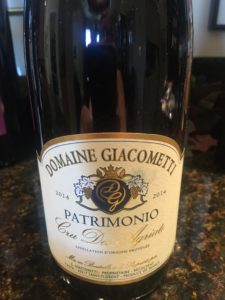
This list is by no means intended to tell you everything you need to know about Sangiovese grapes growing in Italy. That would include a major portion of the country and another 10 pages! Most of the wines we would never even have the opportunity to taste without traveling to Italy and visiting those regions. The intention is to give information about regions, DOCs and DOCGs where Sangiovese plays a significant role in the wine production of that area, and even better yet –- you may learn about wines that have a good chance of travelling to wine stores or restaurants here in the United States. Granted you may have to branch out a bit from the local big box stores. The smaller boutique wine shops are where you have the possibility of finding some of them, and even better yet if you are an online shopper. It is amazing how many wines from these lesser known areas are available if you are willing to search the internet for them. For example, just for this research alone, we were able to source Sangiovese wines from Torgiano Rosso DOCG in Umbria, Romagna DOC, Rosso Piceno DOC in Marche, Colli di Luni DOC in Liguria and Patrimonio DOC in Corsica as well as others not quite as “rare”. Remember the earlier quote about tasting your way through Italian grape varietals?– “If you tasted a new Italian wine each week, it would take you 20 years to taste your way through Italy”! We hope you have been given the inspiration to step out of your “wine comfort zone” a bit and try some unfamiliar grape varietals and regions even if you don’t want to devote 20 years. You may just discover some “Tre Bicchiere” quality wines that are budget-friendly, really enjoyable and worthy of a “three glass” rating just like those given by the Italian food and wine magazine, Gambero Rosso. Happy adventures, winelovers. Saluti and Ciao!
5.11.17 LR
Note from the author:
All of this information is readily available on the internet along with some excellent books written by several reliable wine authors including Hugh Johnson & Jancis Robinson “The World Atlas of Wine”, Karen MacNeil’s “The Wine Bible” and Wine Folly “The Essential Guide to Wine”. I just did the research for you. Please accept my apologies if there is any incorrect data or information; I try my best to verify from several sources. I am an avid winelover and foodie who also really enjoys researching and continuing to learn something new.
What’s up next on www.forkandcorkdivine.com? In Italy, Wine is Food! Stay tuned for an upcoming post that will offer up some information on Italian food and wine pairings along with a few more Italian laws, the DOP. Wine and food make for the perfect Italian marriage, and it is true – if it grows together, it goes together!
Linda Rakos

